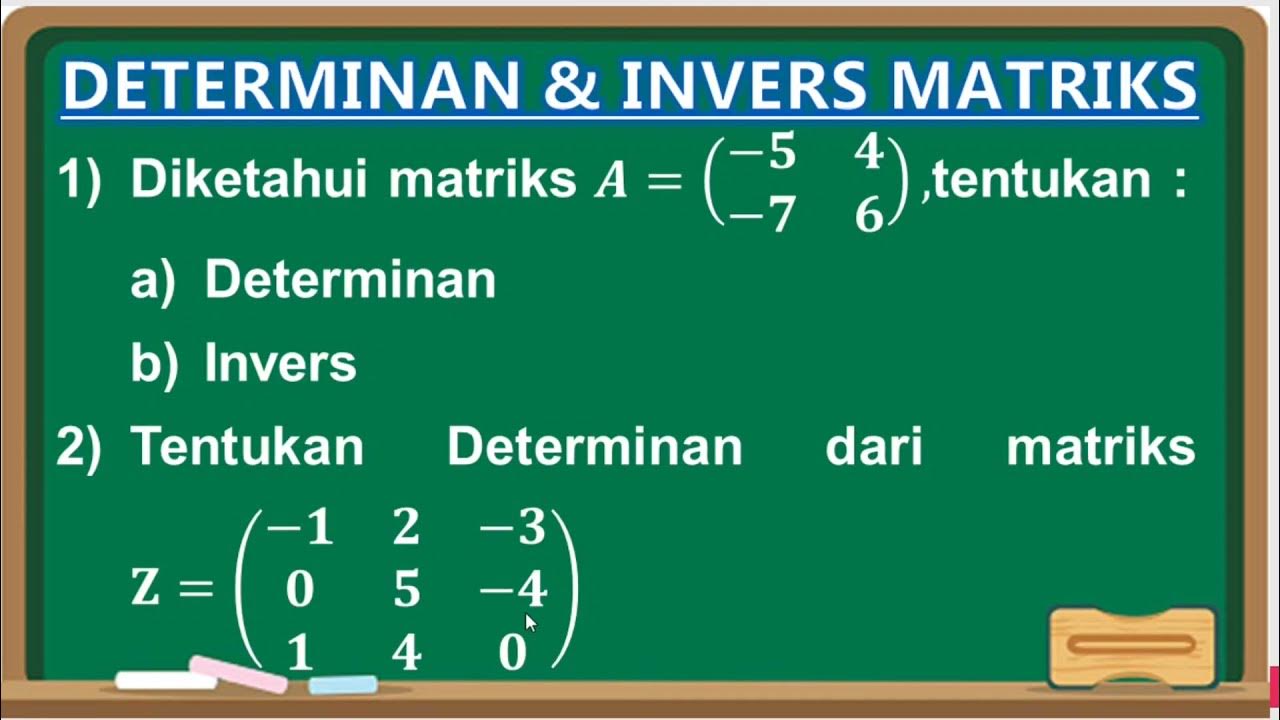SM015: 4.3 INVERSE OF MATRICES - INTRO 2X2 ERO (EXAMPLE 1)
Summary
TLDRIn this video, viewers are introduced to the process of finding the inverse of a 2x2 matrix using elementary row operations (ERO). The presenter explains the various steps, including marking the leading diagonal, applying row operations to eliminate elements below it, and transforming the matrix into an identity matrix on the left side, with the inverse on the right. Through a detailed example involving a matrix with elements 1, 3, 2, and 5, the presenter demonstrates how ERO can be used to find the inverse of a matrix, ultimately arriving at the solution in an easy-to-understand way.
Takeaways
- 😀 The inverse of a 2x2 matrix can be found using elementary row operations (ERO).
- 😀 EROs involve interchanging rows, multiplying a row by a non-zero constant, and adding multiples of rows to other rows.
- 😀 The first step is to create an augmented matrix consisting of the original matrix and the identity matrix.
- 😀 The goal is to transform the left side of the augmented matrix into the identity matrix.
- 😀 Mark the elements on the leading diagonal as part of the first step.
- 😀 The first column is processed first, obtaining zeros beneath the leading diagonal elements.
- 😀 After finishing with the first column, proceed to the second column and then the third, continuing to obtain zeros beneath the diagonal elements.
- 😀 Each step in the row operations should gradually make the left matrix resemble the identity matrix while the right matrix turns into the inverse.
- 😀 Once the left side is the identity matrix, the right side of the augmented matrix will be the inverse of the original matrix.
- 😀 In the final step, normalize the diagonal elements to 1 by dividing each row by its corresponding diagonal element.
- 😀 The inverse of a 2x2 matrix is confirmed by the transformation from the original matrix to the identity matrix and the corresponding values on the right side of the augmented matrix.
Q & A
What is the primary method described for finding the inverse of a 2x2 matrix?
-The primary method described is using elementary row operations (ERO) to transform the given matrix into the identity matrix, which then allows for the inverse to be obtained.
What does ERO stand for, and what does it involve?
-ERO stands for Elementary Row Operations, which involve interchanging rows, multiplying a row by a non-zero constant, or adding multiples of one row to another to manipulate the matrix.
What are the three types of elementary row operations mentioned?
-The three types of elementary row operations mentioned are: 1) Interchanging rows, 2) Multiplying a row by a non-zero constant, and 3) Adding a multiple of one row to another.
What is the purpose of marking all the elements on the leading diagonal in the process?
-Marking the elements on the leading diagonal helps in tracking the key positions in the matrix where transformations are focused, ensuring the eventual reduction to the identity matrix.
Why is it important to get zeros under the leading diagonal in the matrix?
-Getting zeros under the leading diagonal is important because it helps in simplifying the matrix to the identity matrix, a necessary step in finding the inverse of the matrix.
In the example, which matrix is used to find the inverse using elementary row operations?
-The example uses a 2x2 matrix, specifically the matrix [[1, 3], [2, 5]], to demonstrate how to find its inverse using elementary row operations.
How do you create an augmented matrix to find the inverse of a matrix?
-An augmented matrix is created by placing the original matrix on the left side and the identity matrix on the right side. The goal is to transform the left side into the identity matrix through row operations, with the right side becoming the inverse.
What formula is used to perform row operations in the example?
-In the example, the formula used for row operations is: r2 = r2 - 2 * r1, and for r1, it is: r1 = r1 - 3 * r2. These operations are designed to introduce zeros into specific positions in the matrix.
What happens to the matrix once it is reduced to the identity matrix?
-Once the matrix is reduced to the identity matrix, the right side of the augmented matrix contains the inverse of the original matrix.
How is the final inverse of the matrix obtained?
-The final inverse is obtained by continuing the row operations until the left side of the augmented matrix becomes the identity matrix. The right side of the augmented matrix then contains the inverse of the original matrix, which in the example is [[-5, 3], [2, -1]].
Outlines

このセクションは有料ユーザー限定です。 アクセスするには、アップグレードをお願いします。
今すぐアップグレードMindmap

このセクションは有料ユーザー限定です。 アクセスするには、アップグレードをお願いします。
今すぐアップグレードKeywords

このセクションは有料ユーザー限定です。 アクセスするには、アップグレードをお願いします。
今すぐアップグレードHighlights

このセクションは有料ユーザー限定です。 アクセスするには、アップグレードをお願いします。
今すぐアップグレードTranscripts

このセクションは有料ユーザー限定です。 アクセスするには、アップグレードをお願いします。
今すぐアップグレード5.0 / 5 (0 votes)






